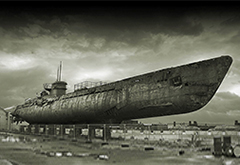Type VII U-boats were the most common type of German World War II U-boat. The Type VII was based on earlier German submarine designs going back to the World War I Type UB III and especially the cancelled Type UG.
 Type VII was designed through the Dutch dummy company Ingenieurskantoor voor Scheepsbouw den Haag (I.v.S) which was set up by Germany after World War I in order to maintain and develop German submarine technology and to circumvent the limitations set by the Treaty of Versailles, and was built by shipyards around the world.
Type VII was designed through the Dutch dummy company Ingenieurskantoor voor Scheepsbouw den Haag (I.v.S) which was set up by Germany after World War I in order to maintain and develop German submarine technology and to circumvent the limitations set by the Treaty of Versailles, and was built by shipyards around the world.
The Finnish Vetehinen class and Spanish Type E-1 also provided some of the basis for the Type VII design. These designs led to the Type VII along with Type I, the latter being built in AG Weser shipyard in Bremen, Germany. The production of Type I was cut down only after two boats; the reasons for this are not certain and range from political decisions to faults of the type. The design of the Type I was further used in the development of the Type VII and Type IX.
Type VII submarines were the most widely used U-boats of the war and were the most produced submarine class in history, with 703 built The type had several modifications. The Type VII was the most numerous U-boat type to be involved in the Battle of the Atlantic. More details
 Type VII was designed through the Dutch dummy company Ingenieurskantoor voor Scheepsbouw den Haag (I.v.S) which was set up by Germany after World War I in order to maintain and develop German submarine technology and to circumvent the limitations set by the Treaty of Versailles, and was built by shipyards around the world.
Type VII was designed through the Dutch dummy company Ingenieurskantoor voor Scheepsbouw den Haag (I.v.S) which was set up by Germany after World War I in order to maintain and develop German submarine technology and to circumvent the limitations set by the Treaty of Versailles, and was built by shipyards around the world.The Finnish Vetehinen class and Spanish Type E-1 also provided some of the basis for the Type VII design. These designs led to the Type VII along with Type I, the latter being built in AG Weser shipyard in Bremen, Germany. The production of Type I was cut down only after two boats; the reasons for this are not certain and range from political decisions to faults of the type. The design of the Type I was further used in the development of the Type VII and Type IX.
Type VII submarines were the most widely used U-boats of the war and were the most produced submarine class in history, with 703 built The type had several modifications. The Type VII was the most numerous U-boat type to be involved in the Battle of the Atlantic. More details